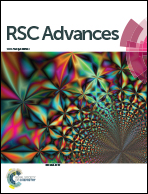High transparency and triboelectric charge generation properties of nano-patterned PDMS
Abstract
Triboelectric charge generation and high transparency properties of the nano-patterned PDMS, which was stamped by silicon subwavelength grating structures as a mold, on indium tin oxide (ITO) coated polyethylene terephthalate (PET) were investigated for triboelectric nanogenerators. At visible wavelengths, the nano-patterned PDMS on ITO coated PET (i.e., ITO/PET) exhibited high transmittances of >85%, together with a theoretical analysis using the RCWA simulation. When the ITO/PET was compressed onto the nano-patterned PDMS on ITO/PET, the output voltage and current density were reliably generated with a short interval time of 0.17 s, which yielded −5.2/5.4 V and −0.57/0.74 μA cm−2, respectively, under a low external pushing force. The effect of pushing frequency on the output voltage and current density was also investigated.


 Please wait while we load your content...
Please wait while we load your content...